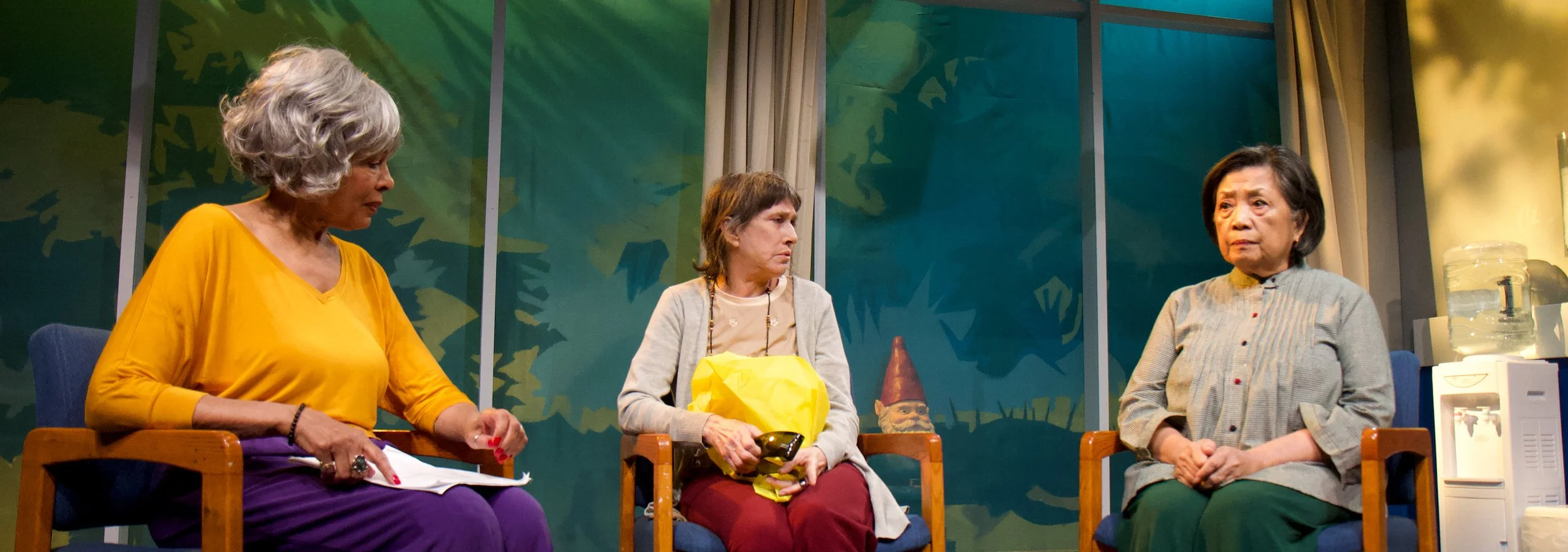Rebecca Taichman’s production of Virginia Woolf’s Orlando, a fantastical tale of sexuality, intrigue and droll social commentary, is the first of planned adaptations of novels that Classic Stage Company’s artistic director, Brian Kulick, has had on his mind for several seasons, according to a program note. Woolf’s model for Orlando was her aristocratic lover Vita Sackville-West, who lived on a medieval estate and was a poet, cross-dresser, and avid gardener in the 1920s. Sarah Ruhl’s model for her adaptation is Paul Sills’ Story Theatre—appropriately, since much of Orlando resembles a fairy tale, and Sills’ 1970 hit was a staged retelling of Grimms’ tales.
Yet Ruhl’s frank love of the prose is her undoing. She culls swaths of the novel and assigns the narration to various characters—apart from Orlando and Sasha, his true love, all the characters are played by a sterling ensemble of three men dressed in white uniforms—Tom Nelis, Howard Overshown and David Greenspan. Lush and lovely, the prose is still inherently undramatic, and the text is the weakest part of the production.
The story begins in the 16th century, when Orlando is invited to the court of Queen Elizabeth I (Greenspan, highly amusing and occasionally brushing up against Miranda Richardson’s QE I from Blackadder). To play the queen (mistakenly called “highness” rather than “majesty”), Greenspan steps into the front half of a bejeweled farthingale lowered from above.
At court Orlando encounters hangers-on and adoring females (each of the ensemble plays one of the hopefuls) and is the beneficiary of a filial relationship with the queen. He also tries to write poetry, but he lacks any imagination. Eventually, to escape a particularly odd admirer, the Archduchess Harriet Griselda of Finster-Aarhorn Scand-op Boom in the Roumanian territory (Greenspan again, doing a hilarious strangulated accent with a burr as he says, “You have the shapeliest legs that any nibbleman has ever stood upon,” and adding “tee-hee” and “ha-ha,” per Woolf’s text), Orlando flees to Constantinople. There, one night after a sexual encounter with a gypsy, the hero falls asleep for a week. When he wakes up, he’s a woman. Moreover, she’s destined to live at least two more centuries, with many more adventures.
Woolf’s overview of love, sexuality and history is enchanting, and probably a wonderful read. And even if one’s patience is often tried by the narration in the CSC production (the scarcity of it in a very late scene with Orlando and Harriet Griselda, who has revealed a great secret, is a refreshing lark), Taichman and her collaborators have staged the piece strikingly. Allen Moyer’s large square of green grass at center stage is reflected above by an enormous mirror with elaborately carved frame hanging at a tilt. Upstage are three golden thrones for the ensemble. And a miniature lighted palace is always present, on the floor or carried about. When winter comes, a large white cloth is drawn over the greenery.
Choreographer Annie-B Parson keeps the ensemble moving in dance as Orlando speaks at length, although Francesca Faridany has superb diction and passionate delivery that keep one’s attention riveted on her (so do all the actors, including Annika Boras as Sasha). Christopher Akerlind’s lights variously underline the story’s clarity or eerieness. Anita Yavich’s costumes of white for the ensemble are occasionally used to set off, for instance, large red ostrich fans wafted over Orlando in the Turkish capital, or a stunning cobalt jacket for Tom Nelis, who plays the heroic Marmaduke Bonthrop Shelmerdine, Orlando’s true love, and also shines as a frustrated female admirer.
“They had guessed everything of any importance between each other,” a narrator explains: “You’re so entirely sympathetic and you never take more than 10 minutes to dress,” says Marmaduke in a bit of praise that exemplifies Woolf’s typically sly social satire. Christian Frederickson and Ryan Rumery’s music and sound range from harpsichord, violin and baroque instruments to 20th-century minimalism as the centuries progress.
One’s response to Orlando may well depend on whether one has read the novel. To this reviewer, who hadn’t, the bizarre story is clearly told, but the result is highly theatrical without being a satisfying play. Indeed, when so much of world drama is so rarely produced—Wedekind, Schnitzler, Massinger, Marston, Marivaux, Southerne, Pirandello, just to name a few—one may fairly wonder why CSC feels it necessary to bring a novel to the stage at all. Shouldn’t the company concentrate more on unearthing works created with theater in mind, such as Ostrovsky’s The Forest last season? Orlando has some wonderful moments, but the top-heavy narrative keeps it earthbound. It’s the stunning visuals that outshine what is essentially a live-action version of books on tape.






